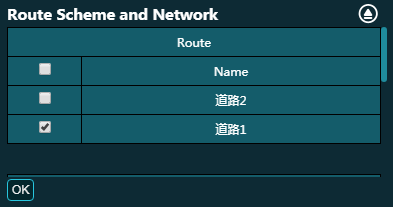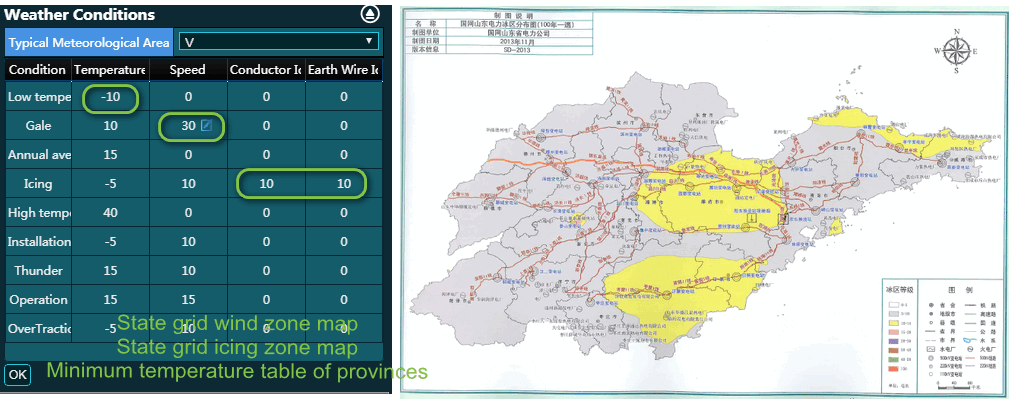If the project is during Phase II, refer to the existing material for accurate design parameter inputs.
The Greenwich power line product V2.0 consists of three calculation types: wire optimization, tower arrangement, and electric check. Among them, the wire optimization algorithm consists of aerial route algorithm, cable route algorithm, and mixed route algorithm.


- Under common conditions, it is recommended to select mixed route algorithm.
- Select cable route algorithm when you encounter the following conditions:
- The project is in the typhoon area. (Wind speed > 30 m/s. Check the wind zone map in China for details.)
- The project is in the frequent thunderstorm area (Thunderstorm day ≥ 90 days. Check http://www.cxspd.com/lbr-cx.html for details.)
- The project is in the heavy icing area (Icing thickness ≥ 15 mm. Check the ice zone map in China for details.)
- The aerial scheme is not applicable due to policy reason or other reasons of project.
- The aerial scheme is not applicable technically for the project, such as span.
- If you want to compare the economic result of the three algorithms, perform the calculation of each of them.
While importing external map or route scheme, ensure all input files are in the same coordinate system or can be converted to the same one. Ensure the imported route scheme, turbine layout scheme, map file, avoid area file, etc. are in the corresponding coordinate system or can be converted to the same one.


Avoiding range is consisted of buildings, basic farmland, mineral area, forest area, natural protection zone, etc. For each of the three schemes, aerial, cable, mixed route schemes, define these avoiding ranges to avoid to design within them.
If the project-related avoiding ranges are too many (over 20), it is recommended to perform wire optimization calculation, draw the areas over the avoiding ranges, and perform the wire optimization calculation again over the power line scheme.
Four terrain options are available for wire optimization: hilly area, flat ground, heavy icing flat ground, and heavy icing hilly area. Judge your selection according to the contour map and icing thickness of the project.
- When the icing thickness is less than 15 mm, altitude is more than 500m, and relative height difference is no less than 200 m, select hilly area.
- When the icing thickness is no less than 15 mm, altitude is more than 500m, and relative height difference is no less than 200 m, select heavy icing hilly area.
- When the icing thickness is less than 15 mm, altitude is less than 500m, and relative height difference is less than 200 m, select flat ground.
- When the icing thickness is no less than 15 mm, altitude is less than 500 , and relative height difference is less than 200 m, select heavy icing flat ground.
The relative height difference is the height difference between the highest and lowest points in the wind farm.
Seven terrain options are available for wire optimization: sand, water, farm, wild, bush wild, low bush, and forest. Judge your selection according to the reconnaissance and information collection conditions from the project.
After the route optimization calculation is completed, check the applicability of the circuit scheme according to the following rules:
- The selection of aerial circuit scheme should follow the requirements below:
- Avoid crossing with other facilities. If the aerial wire crosses other wires, do not locate the cross point at the tower top of the spanned wire.
- Avoid to locate aerial circuit within depression, scoured zone, ill geologic area, virgin forest, and other areas influencing secure operation of wires.
- Do not erect aerial circuits across forest. If it is inevitable, avoid deforestation by selecting wire paths based on the roads and other specific conditions in the forest. For 35 kV and 66 kV aerial wires, design them in the span form. In special areas, restrict deforestation with consideration of electric safe distance at the specific district.
- Aerial wires should not go through the core zone and buffer zone of the natural protection zone authorized by the country.
- The selection of cable wire scheme should follow the requirements below:
- In principle, lay the wires along the wind farm road. The start point is turbine or turbine transformer, and the end point is substation.
- Avoid mineral area, basic farmland, and districts influenced by severe erosion of acid, alkali, and random current electrochemistry.
- Without safeguard measures, avoid areas harmed by white ant, heat source, and districts vulnerable to external damage.







